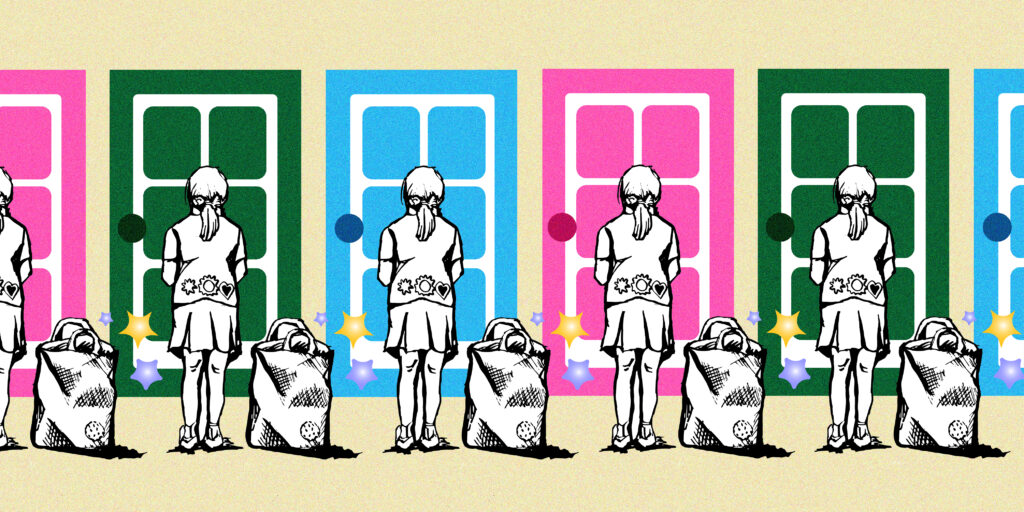The season has passed when the girls (and their guardians) are loading up the wagons, setting up tables, and selling the beloved, but seasonal Girl Scout Cookies. Whether you go for the low-key shortbread cookie (Trefoils) or the high-powered Caramel deLites (formerly Samoas), most of us are delighted to see the girls in brown and green hawking their wares in the winter.
Today, though, the scouts rarely go door to door to sell. They, or their parents, are savvy enough to know that one of the four Ps of marketing is “place”; consequently, you see them outside supermarkets, places of worship, transportation terminals, or at other high-traffic pedestrian spots. As with kids’ lemonade stands during warm weather, I am motivated to buy from these youth, to claim a modicum of contribution to a kid going to a prestigious B-School someday and subsequently becoming a purpose-driven entrepreneur that in some way improves the human condition. Or B-School be damned — maybe I’m just filling some kid’s quota.
Regardless of the type of club, organization, or school, parents of every generation have come to expect there will be fundraisers to defray the cost of some worthwhile experience for their kids. Children eventually come home with money-raising products such as candy, wrapping paper, candles, magazines, and if enrolled in Catholic school, parochial schoolchildren historically have been asked to sell Christmas stamps.
Understandably, some parents opt to make the required fundraising goal for their kids by buying out the product, thus earning their children a seller’s consolation prize — even if it is the lowest reward. Now, imagine the pressure for both the seller and the parents who have many children? I am one of 16 children, and while we were the largest family in the neighborhood, there were many double-digit-sized families who were busy with mundane matters. Add to this challenge not only the many large Catholic families, but I grew up in a neighborhood that had many Orthodox Jewish families as well — there were kids everywhere.
For these children, coming home with stock to sell had internal and external competition. Parents were unlikely to buy out the fundraiser stash for each of their children. So, what did these children do? They hit the streets and learned the trials and tribulations of door-to-door sales.
Looking back, our parents were less concerned about the money, because having us sell on the streets was an easy opportunity to work in any number of “life lessons.” Even if they had a favored child, to keep the peace, they knew not to invoke the buyout strategy, or they’d never hear the end of it from the other siblings.

Not benefitting from the buy-out-the-stock strategy didn’t seem to bother us kids from big families, as much as having to settle for the consolation prize almost every time there was a fundraiser. The vendors of the Christmas stamp program only ever seemed to change up the prizes for the medium to high sellers, so when we didn’t sell much, my Catholic school-going siblings often bagged the token low-sales reward. As a result, we had a stash of slim-line Blessed Mother statues in our home. One bit of relief was the statue could be given away as a birthday gift, for which there were many; and God forbid a sibling complained about getting a statue of Immaculate Mary on his/her birthday. You smiled and said, “Thank you,” and thought about the sundry of siblings’ birthdays for which you could re-gift the statue. Furthermore, over time us Gambescia kids developed a Communitarian spirit wherein we were not bothered by getting a little less. When it was your turn to get a little extra something, it became more meaningful; anticipation has its rewards!
One sales item that belied commonsense was having to sell lightbulbs for the Webelos: “We’ll be Loyal Scouts” [someday]. Not commonly known, the Webelos is a short transition period from a Cub Scouts pack to a Boy Scouts Troop. Initially, we were excited to shred the sectarian imprimatur that should help us boost sales in the neighborhood — until we went a-knocking . . . The neighbors, understandably, looked befuddled: “You are selling what?” Whoever cut that deal for the Scouts in those days must have gone to one of those “use inspired” research universities.
Selling lightbulbs as a kid sucked the fun out of going door to door hawking frivolous items for which we at least had a fighting chance to sell. Trying to sell these electric filaments eliminated the sympathetic buyer. Folks either had no need for lightbulbs or took umbrage that we tacitly suggested they were skimping on taking care of temporal matters in their homes.
The real work came when our poor parents received the nondescript paper bags filled with each patron’s lightbulb order and the “fragile” warning stickers to notify us kids . . . This meant Mom and Dad had to be co-opted into the delivery phase, as they could not trust a rambunctious boy, while ostensibly “trustworthy,” to deposit lightbulbs to buyers, without incident; otherwise, parents would be left to buy out the stock of damaged goods.
By high school, it was obvious that our parents were not going to change their strategy; therefore, for low sellers to move out of the token prize category, my siblings and I had to pound the pavement and knock on doors. What made door-to-door sales even more challenging was competition from neighborhood Baby Boomer children who were also selling their fundraising wares. Naturally their homes were off our prospect list, given they had the same no-buyout-clause from their parents.
Remember: The neighborhood we lived in not only had big Catholic families, but also many Orthodox Jewish families, so, understandably, selling Christmas stamps or Easter Seals to these homes was not a good fit. Our parents never pointed this out, giving testimony to their lack of religious prejudice. So, behind a veil of ignorance, we went knocking on any home, hoping that some stranger would give an industrious kid a break What we learned on the streets — think Hunger Games marketing strategy —was really what any salesperson knows: When you go knocking for the exchange of a commodity for money, expect all kinds of responses. To entertain ourselves, we tried to create profiles of the people answering doors to predict if they would buy something. There were those that opened the door just a crack, and those prospects that invited us in as if we were staying for dinner. While the latter were warm and wonderful, even as a kid, you knew the economics of opportunity cost. Productive salespersons not only want to close the sale but get to the next customer in a timely manner as well… A homeowner’s disposable income (sometimes shown by their model car or how well-kept a home seemed), were not good predictors of takers. Does the homeowner have a dog? What type of fence — if any? These early impressions taught us to temper our conjecture of human behavior. English singer Robert Palmer was right: “It takes every kind of people, to make the world go ‘round.”
One brother had a banner year with a cash award sweepstakes raffle in his all-boys Catholic high school. Tired of the obligatory low sales token prize, he would not be denied a shot at this fundraiser’s top reward. He worked the streets each day after school, sometimes even after dark. Given enough effort, he learned he could sell raffle tickets — and then some. He had no delusions of being the top seller in school, but by the end of each week, he was turning in more and more tickets sold. His homeroom became one of the top sellers and excitement began to build. At the end of the program, it was announced over the school loudspeaker that he was the top seller of raffle tickets. Lessons learned: Focus on the job, and the rewards will follow. Keep a positive attitude. Add a personal touch. Deal with rejection and move on.
One of his classmates insisted my parents “bought out” the tickets because our “father had the means to do so.” Little did he know. My brother’s best takeaway from this: He’s thankful to our parents for letting him loose on the streets to discover for himself the value of a disciplined habit of industry.
Steve Robertson, author of a front-runner book on Gen Z, (Aliens Among Us: Ten Surprising Truths about Gen Z), recommends to parents that in order to connect to this new generation, you need to find a mutually uncommon ground. Unlike Boomers, kids today would probably not be enamored with going door to door with “an amazing new offer.” (Except for the prize part!) And parents may want to nip the fundraising efforts in the bud and just buy out the stock. But maybe that’s what we need today. A parent/child sales force going door to door could be a neat “life lesson” for both. Safety concerns eliminated, going door to door seems the perfect homework assignment from the School of Hard Knocks.
And there are more teachable moments than the dreaded diorama projects. You’ll quickly discover that not every door opens with a welcome smile and a signature. Sometimes, you’re met with a chorus of barking dogs, slammed doors (or doors that never open), and occasionally, you’ll get caught in a conversation and never sell anything. But fear not, in this quirky classroom of transactions — and snubs — you’ll discover the art of the sales pitch, and you’ll learn perseverance. You’ll realize what it takes to not dwell on the “no’s,” but to accelerate to the “yes” customers. You’ll grow thicker skin. You’ll acquire a smile in the face of adversity.
So, if your doorbell rings sometime soon with a family of salespeople — applaud their entrepreneurial spirit, even if you don’t open the door.•




